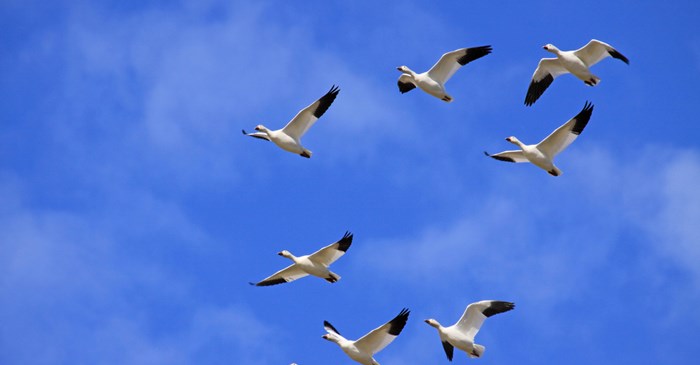As summer gives way to fall, many birds begin to move from their spring and summer breeding grounds to their winter homes. This is a good time to watch and help birds make the seasonal transition. Here are answers to your top 10 questions about fall bird migration in the United States.
1. Do all birds migrate?
No. Some birds, such as the northern cardinal and northwestern crow, don’t need to migrate because they can find food in their home ranges throughout the winter. Hairy woodpeckers often remain year round, except in northernmost areas.
2. When does fall migration begin?
That depends on where you live. Seasonal changes start in early September through late November, although birds in the Arctic begin migrating much earlier. Even in northern regions, migration varies even though the dwindling number of daylight hours is the same from year to year. "The range of some species can expand or contract fairly rapidly, with changes occurring in time periods shorter than the re-publication time of a field guide," say the experts at the Cornell Lab of Ornithology.
3. Why do birds migrate in fall?
Decreasing number of hours of light and cooler temperatures both help birds know it’s time to move on. But the most important reasons for migration are changes in food sources, especially insects, and changes in nesting locations as trees lose their leaves. The weather you’ve experienced this year can also play a role. For example, drought conditions may make food and water harder to find, so birds leave earlier than in years with sufficient rainfall.
4. How far do birds migrate?
It depends on the bird. Short-distance migrants, such as blue grouse, bridled titmouse, and northern bobwhite, may simply change altitudes, heading to lower elevations for winter. Medium-distance birds, including blue jay, eastern bluebird, killdeer, and white-crowned sparrow, roam around to find better conditions but generally stay within North America. Blue jays in particular seem to play a game of roulette in which they stay put one winter and then fly south in the summer or vice versa. Some 350 species are considered long-distance "neotropical" migrants, spending summers in the U.S. and Canada, then wintering in warmerclimates from the Caribbean to northern parts of South America. These include raptors, vultures, waterfowl, shorebirds, hummingbirds, thrushes, warblers, orioles, and tanagers, according to the Cornell Lab of Ornithology. The winners in the long-distance category are whooping cranes and Arctic terns, which can travel 2,500 miles and as much as 24,000 miles, respectively.
5. How do birds know where to travel?
Scientists are still trying to unlock that mystery. The Cornell Lab of Ornithology says that birds migrate using a variety of techniques, including "navigation by the stars, sensing changes in the earth's magnetic field, and even smell."
6. How do birds change during fall migration season?
Birds that migrate at night start changing their routines. Some male birds, such as the eastern goldfinch, lose the bright plumage that helps them attract a female during spring or summer mating season, making them closer in appearance to females for most of the year. Male ducks also molt to a dull-colored plumage after mid-summer breeding.
7. What time of day do birds take flight for migration?
Some fast fliers, such as hummingbirds, finches, swifts, swallows, birds of prey, pelicans and herons, are considered diurnal, or daytime migrants. Others are nocturnal, taking off within an hour of sunset and flying through the night. These include waterbirds, cuckoos, flycatchers, thrushes, warblers, orioles and buntings.
8. When should I take my hummingbird feeder down?
Keep your feeders up for three weeks beyond the last date you see a hummingbird. Hummers have a strong migrating instinct and don’t linger even if you keep food available, but there may be some stragglers who need energy for their flight to come.
9. How fast do migrating birds fly?
That varies by bird, but generally 20 to 50 miles per hour. "For sustained flight, larger birds typically fly faster than smaller birds," according to the USGS Northern Prairie Wildlife Research Center in Jamestown, North Dakota. "A common flying speed of ducks and geese is between 40 and 50 miles per hour, but among the smaller birds it is much less.
10. Where can I watch birds during fall migration?
Some locations are known as migration "hot spots" where large numbers of birds can often be seen in large numbers. The National Audubon Society lists these six locations as among the best in the United States: Cape May, New Jersey; Bill Baggs Cape, Florida State Park, Florida; Great Salt Lake, Utah; Monterey Bay, California; Izembek Lagoon, Alaska; and Hawk Ridge, Duluth, Minnesota.
So, how can I help birds during fall migration?
Migrating birds bulk up and add fat so they have enough fuel to take them on their long journey, so providing food to help them can help. Lyric Delite is a high-protein, no-waste wild bird mix featuring a blend of select shell-free nuts and seeds.
Because bright lights can disorient night migrating birds, turn off lights that aren't needed, and encourage owners of tall buildings in your community to do the same. Landscape your yard with fall in mind, adding plants that produce fruit or seeds for food. Finally, consider joining eBird, a real-time, online checklist program started in 2002 by the Cornell Lab of Ornithology and National Audubon Society to collect data about birds.
